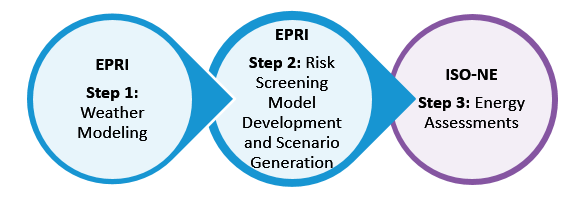Initial results from study of weather’s impact on energy security show relatively low short-term risk

Preliminary results from a first-of-its-kind study examining how New England’s electric power system would fare under stressful weather and operational conditions show the chances for an energy shortfall are relatively low in winter 2027, the first season studied.
The low risk assessment is detailed in the Operational Impact of Extreme Weather Events, a joint effort of ISO New England and the Electric Power Research Institute (EPRI), an independent, nonprofit energy research and development organization.1 While these first results are an important output of the study, they represent just one snapshot in time of a rapidly evolving grid.
The initial results of this probabilistic study align with results from the ISO’s deterministic assessments looking at winters 2023–2024 and 2024–2025.2
The Operational Impact of Extreme Weather Events study’s results for 2027 and beyond are intended to inform the region about future energy adequacy risks. By helping to quantify these potential risks, the results will offer context for assessing possible solutions.
“In the long term, one of the benefits of this work is the creation of a framework we can use to repeatedly assess future scenarios as climate projections are refined and the resource mix evolves,” said Stephen George, director, Operational Performance, Training, and Integration.
Process and findings
Recognizing the increasingly important role weather plays in power system operations, the study examines how factors like temperature, cloud cover, and wind speed will impact electric power generation in the future, when the regional grid is more heavily powered by renewable resources sensitive to these conditions. The study also takes into account the evolving grid demand patterns that will continue to change as more behind-the-meter photovoltaic (BTM PV) resources come online and electrification of the heating and transportation sectors increases.
The study is being undertaken in three major steps, with EPRI providing weather modeling and risk screening model development, and ISO New England completing the actual energy assessments, using the enhanced 21-day energy assessment tool. The 21-day tool is a one-of-a-kind energy supply outlook that offers a three-week analysis of anticipated power system conditions, taking into consideration variables such as fuel supplies, weather, and electricity demand.

The preliminary results include three key findings about how New England’s grid might fare in winter 2027 with and without energy resources, including the Everett Marine Terminal liquefied natural gas facility, the New England Clean Energy Connect (NECEC) transmission line, and varying levels of wind and solar energy:
- Some energy shortfall risk is present, particularly in a worst-case event that modeled a 12-day cold snap with low wind and little solar production. The study found the ISO and other entities would likely be able to take steps to mitigate a projected shortfall under such circumstances.
- Additional imports delivered via NECEC mitigate the risks for energy shortfalls.
- The study found that there is similar risk for energy shortfalls with and without the Everett Marine Terminal. The study also found that significant generation by oil- and coal-fired resources would be needed to minimize the extent of energy shortfalls, especially in worst-case scenarios.
Preliminary results focused on winter 2027 were presented at the May 16 NEPOOL Reliability Committee meeting. Winter 2032 is the next time period the study will assess, with results expected later in the year.
“Our goal is that as we gain more experience with this simulation, we will be able to run scenarios in real-time to assess energy adequacy risks and take appropriate measures to mitigate such risks within the 21-day forecast horizon,” said Vamsi Chadalavada, executive vice president and chief operating officer.
1While this analysis assumes a significant amount of outages on the system, it should not be viewed as assessing the impact of a sudden large scale, long-duration contingency.
2A probabilistic study estimates the level of certainty of an event taking place, and recognizes that the inputs are uncertain. A deterministic study is a type of analysis based on a snapshot of assumed specific conditions for a specific scenario, which does not quantify the likelihood that these conditions will actually materialize.
- Categories
- Inside ISO New England
- Tags
- system operations, weather, winter
